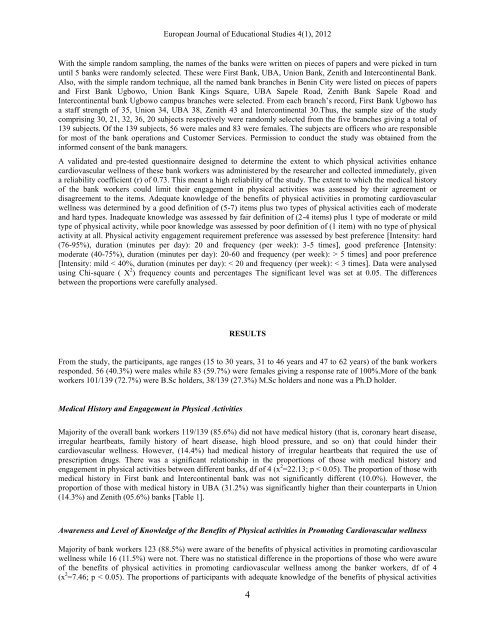Volume 4 Issue 1 (February 2012) - Ozean Publications
Volume 4 Issue 1 (February 2012) - Ozean Publications
Volume 4 Issue 1 (February 2012) - Ozean Publications
Create successful ePaper yourself
Turn your PDF publications into a flip-book with our unique Google optimized e-Paper software.
European Journal of Educational Studies 4(1), <strong>2012</strong><br />
With the simple random sampling, the names of the banks were written on pieces of papers and were picked in turn<br />
until 5 banks were randomly selected. These were First Bank, UBA, Union Bank, Zenith and Intercontinental Bank.<br />
Also, with the simple random technique, all the named bank branches in Benin City were listed on pieces of papers<br />
and First Bank Ugbowo, Union Bank Kings Square, UBA Sapele Road, Zenith Bank Sapele Road and<br />
Intercontinental bank Ugbowo campus branches were selected. From each branch’s record, First Bank Ugbowo has<br />
a staff strength of 35, Union 34, UBA 38, Zenith 43 and Intercontinental 30.Thus, the sample size of the study<br />
comprising 30, 21, 32, 36, 20 subjects respectively were randomly selected from the five branches giving a total of<br />
139 subjects. Of the 139 subjects, 56 were males and 83 were females. The subjects are officers who are responsible<br />
for most of the bank operations and Customer Services. Permission to conduct the study was obtained from the<br />
informed consent of the bank managers.<br />
A validated and pre-tested questionnaire designed to determine the extent to which physical activities enhance<br />
cardiovascular wellness of these bank workers was administered by the researcher and collected immediately, given<br />
a reliability coefficient (r) of 0.73. This meant a high reliability of the study. The extent to which the medical history<br />
of the bank workers could limit their engagement in physical activities was assessed by their agreement or<br />
disagreement to the items. Adequate knowledge of the benefits of physical activities in promoting cardiovascular<br />
wellness was determined by a good definition of (5-7) items plus two types of physical activities each of moderate<br />
and hard types. Inadequate knowledge was assessed by fair definition of (2-4 items) plus 1 type of moderate or mild<br />
type of physical activity, while poor knowledge was assessed by poor definition of (1 item) with no type of physical<br />
activity at all. Physical activity engagement requirement preference was assessed by best preference [Intensity: hard<br />
(76-95%), duration (minutes per day): 20 and frequency (per week): 3-5 times], good preference [Intensity:<br />
moderate (40-75%), duration (minutes per day): 20-60 and frequency (per week): > 5 times] and poor preference<br />
[Intensity: mild < 40%, duration (minutes per day): < 20 and frequency (per week): < 3 times]. Data were analysed<br />
using Chi-square ( X 2 ) frequency counts and percentages The significant level was set at 0.05. The differences<br />
between the proportions were carefully analysed.<br />
RESULTS<br />
From the study, the participants, age ranges (15 to 30 years, 31 to 46 years and 47 to 62 years) of the bank workers<br />
responded. 56 (40.3%) were males while 83 (59.7%) were females giving a response rate of 100%.More of the bank<br />
workers 101/139 (72.7%) were B.Sc holders, 38/139 (27.3%) M.Sc holders and none was a Ph.D holder.<br />
Medical History and Engagement in Physical Activities<br />
Majority of the overall bank workers 119/139 (85.6%) did not have medical history (that is, coronary heart disease,<br />
irregular heartbeats, family history of heart disease, high blood pressure, and so on) that could hinder their<br />
cardiovascular wellness. However, (14.4%) had medical history of irregular heartbeats that required the use of<br />
prescription drugs. There was a significant relationship in the proportions of those with medical history and<br />
engagement in physical activities between different banks, df of 4 (x 2 =22.13; p < 0.05). The proportion of those with<br />
medical history in First bank and Intercontinental bank was not significantly different (10.0%). However, the<br />
proportion of those with medical history in UBA (31.2%) was significantly higher than their counterparts in Union<br />
(14.3%) and Zenith (05.6%) banks [Table 1].<br />
Awareness and Level of Knowledge of the Benefits of Physical activities in Promoting Cardiovascular wellness<br />
Majority of bank workers 123 (88.5%) were aware of the benefits of physical activities in promoting cardiovascular<br />
wellness while 16 (11.5%) were not. There was no statistical difference in the proportions of those who were aware<br />
of the benefits of physical activities in promoting cardiovascular wellness among the banker workers, df of 4<br />
(x 2 =7.46; p < 0.05). The proportions of participants with adequate knowledge of the benefits of physical activities<br />
4

















